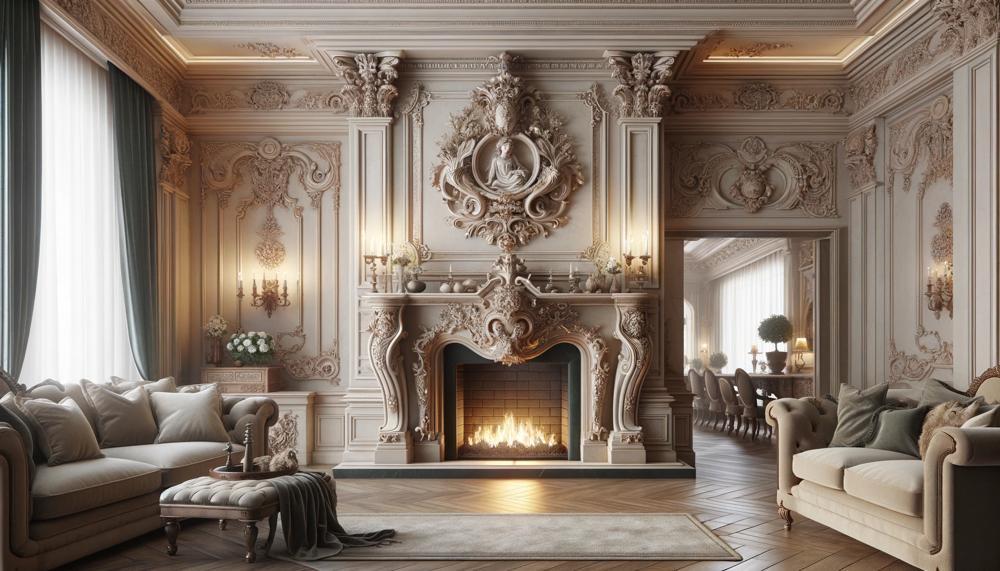Do you find yourself constantly rearranging the furniture in your living room, trying to achieve the perfect layout? While many elements go into creating a well-designed space, one often overlooked detail is the depth of a fireplace mantle.
But don’t be fooled – this seemingly small feature can make a big impact on the overall aesthetic and functionality of your room.
So, how far should a fireplace mantle stick out?

Wood mantels and other flammable items must be at least six inches away from the firebox entrance under the National Fire Code. An extra inch of space is required for every 1/8 inch that the flammable material protrudes. An example of this would be to install a mantel that is 6 inches deep, 18 inches above the firebox hole.
In this blog post, we’ll delve into these points further and help you determine the perfect depth for your fireplace mantle. So grab yourself a warm drink, cozy up by the fire, and let’s get started.
Contents
- 1 How Far Should a Mantle Stick Out?
- 2 Fireplace Mantel Clearance
- 3 What Is the Standard Size of a Fireplace Mantel?
- 4 How Wide Should a Fireplace Mantel Be?
- 5 How Long Should a Mantle Be?
- 6 How Deep Should a Mantle Be?
- 7 How High Should a Mantle Be?
- 8 How Thick Should a Fireplace Mantel Be?
- 9 How High Should a Mantle Be Above a Wood Burner?
- 10 Extending a Fireplace Mantel
- 11 How to Install a Fireplace Mantel – Step-By-Step
- 11.1 Measure the Space Around the Fireplace Opening
- 11.2 Take Material and Overhang into Account
- 11.3 Follow the “Golden Rule”
- 11.4 Divide Mantel Shelf Width by 2
- 11.5 Consider Depth Based on Traffic Flow
- 11.6 Follow Recommended Height Guidelines
- 11.7 Choose the Appropriate Thickness
- 11.8 Properly Assemble and Install Mantel Pieces
- 12 Conclusion
How Far Should a Mantle Stick Out?
When it comes to fireplace mantles, there is a recommended distance of 12 inches that it should stick out from the wall.
This measurement is not only based on safety regulations but also traditional design principles, resulting in both a safe and visually appealing fireplace. However, this distance may differ depending on the type of fireplace and the materials used for the mantel.
It is crucial to take these factors into consideration when deciding the appropriate distance for your unique fireplace.
Fireplace Mantel Clearance
According to the National Fire Protection Association (NFPA), the recommended allowance for a fireplace mantel to safely extend from the wall is 12 inches.
However, this measurement may differ depending on the material of the mantel and its distance from flammable objects.
What Is the Standard Size of a Fireplace Mantel?
The dimensions for a fireplace mantel are typically determined by the width and height of the fireplace opening. A standard mantel will extend 8-12 inches on either side of the fire opening, creating a well-balanced and visually pleasing look. However, these measurements may vary depending on personal preference and customizations.
To determine the appropriate size for your fireplace mantel, it is crucial to first measure the width and height of your fireplace opening. This will provide a general guideline for the width and length of your mantel. For instance, if your fireplace has a width of 48 inches, then a mantel between 40 and 56 inches would be suitable.
Along with standard size guidelines, safety distances should also be considered when installing a fireplace mantel. The National Fire Protection Association (NFPA) recommends a minimum distance of 12 inches between the top of the fireplace opening and the bottom of the mantel. However, this distance may vary depending on the material used for the mantel and its proximity to potentially flammable items.
When adjusting measurements for different fireplace sizes, it is important to maintain proportions and balance. A larger fireplace may require a wider or longer mantel to ensure visual harmony, while a smaller fireplace may benefit from a narrower or shorter mantel.
Moreover, customization options allow for unique designs and sizes that can beautifully complement any fireplace size and style.
How Wide Should a Fireplace Mantel Be?
When considering the ideal width for a fireplace mantel, there are several factors that come into play.
Other important considerations include the size of the room and ceiling height, the chosen style and design of the room, and any functionality or safety guidelines that should be taken into account.
How Long Should a Mantle Be?
This not only allows for ample space for decorative items but also ensures proper safety and proportionality with the rest of the fireplace and room.
In determining the length of a mantle, it is crucial to take into account both the size of the firebox opening and any facing that may be present around it. For instance, if the firebox measures 36 inches in width, then the mantle should extend at least 6 inches on each side, resulting in an overall length of 48 inches. If there is additional facing around the firebox, then the mantle can extend even further beyond the opening.
Furthermore, it is important to consider the overall size and scale of the room when deciding on mantle length. A larger room with high ceilings may require a longer mantle in order to maintain proper proportionality and visual impact. Conversely, a smaller room with lower ceilings may call for a shorter mantle to avoid overwhelming the space.
In addition to aesthetics, safety should also be taken into consideration when selecting mantle length. The further the mantle extends from the wall, the greater the potential for it to become a hazard if not properly secured. Therefore, ensuring that the mantle is securely attached to the wall and capable of supporting any weight placed on it is essential.
How Deep Should a Mantle Be?
When contemplating the ideal depth for a fireplace mantle, it is crucial to take into account the safety measures and codes established by the NFPA. These codes exist to guarantee the safety of using the fireplace and its surrounding area. The recommended depth of 6-7 inches provides ample space between the mantel and the firebox opening, mitigating any potential hazards.
Moreover, having a recommended depth also allows for aesthetic purposes. During the holiday season, many individuals enjoy adorning their mantels with festive decorations like stockings, garlands, and other seasonal items. A deeper mantle offers more room to showcase these decorations without posing any fire risks.
However, it is imperative to note that the recommended depth of 6-7 inches is merely a guideline. The actual depth of a fireplace mantle can vary depending on personal preferences and room proportions. It is always advisable to seek advice from a professional or follow manufacturer’s recommendations when installing a fireplace mantle.
How High Should a Mantle Be?
According to the National Fire Protection Agency (NFPA), the recommended height for a fireplace mantle is at least 12 inches above the fireplace opening. This guideline is crucial for ensuring safety and avoiding potential fire hazards.
However, it is essential to note that the exact height may vary based on factors like the fireplace size, depth, and ceiling height.
Finding the Right Height: Factors to Consider
When determining the ideal height for a fireplace mantle, several factors must be taken into account. The NFPA code requirement of at least 12 inches above the fireplace opening should always be followed for safety purposes. However, personal preferences and room proportions can also play a role in deciding the perfect height for a mantle.
Additionally, the usage of the mantle, such as displaying artwork or placing decorations, can also impact the height choice.
How High Should a Mantle Be?
The recommended height for a mantle is usually around 60 inches (5 feet) from the floor. However, this can vary based on factors like room size and personal preferences. To help guide homeowners in choosing the right mantle height, here are some general recommendations based on room size:
- In small rooms, it is recommended to mount the mantel at 55 inches from the floor to create an illusion of space and prevent overcrowding.
- In medium-sized rooms, 60 inches from the floor is considered an ideal height as it creates balance and symmetry.
- For larger rooms, it is suggested to place the mantle at 65 inches from the floor to maintain proportion and avoid a disproportionate look.
Professional Advice and Manufacturer’s Recommendations
To ensure both safety and aesthetics when installing a fireplace mantle, seeking professional advice or following manufacturer’s recommendations is highly recommended. They can provide personalized recommendations based on your specific fireplace and room dimensions. This will not only ensure safety but also enhance the overall look and feel of your space.
Insights:
- The recommended height for a fireplace mantle is based on fire safety codes to prevent fire hazards.
- The height can also be adjusted based on personal preferences, room size, and mantel usage.
- Seeking professional advice or following manufacturer’s recommendations is recommended for a safe and aesthetically pleasing installation.
How Thick Should a Fireplace Mantel Be?
The standard thickness measurements for a fireplace mantel can vary depending on the material and style.
When it comes to traditional wood mantels, the standard thickness typically falls between 1.5 to 2 inches. However, for more contemporary designs, the average thickness can range from 3 to 5 inches.
On the other hand, stone mantels generally have a standard thickness of about 2 inches. The thickness of a mantel is essential for both safety and visual appeal.
A thicker mantel can provide better support and protection for items placed on top, while simultaneously enhancing the overall aesthetic of the fireplace. It also serves as insulation and helps prevent heat loss during cooler months.
However, if a mantel is too thin, it may not offer enough support and can pose safety hazards. It may also look disproportionate to the rest of the fireplace, negatively impacting its appearance.
It is crucial to consider both safety and aesthetics when determining the appropriate thickness for your fireplace mantel.
How High Should a Mantle Be Above a Wood Burner?
Research has shown that in order to ensure safety and proper function, a mantle should be placed at least 8 inches (0mm) above a wood burner. This recommended clearance is crucial for preventing potential fire hazards and ensuring efficient operation of the wood burner.
| Material/Style | Mantel Thickness | Recommended Distance Above Wood Burner |
| Traditional Wood | 1.5-2 inches | 8 inches (0mm) |
| Contemporary | 3-5 inches | 8 inches (0mm) |
| Stone | 2 inches | 8 inches (0mm) |
It is important to understand that the recommended distance may vary depending on the manufacturer and model of the wood burner. Therefore, it is advisable to refer to the manufacturer’s guidelines or seek professional advice for specific recommendations.
Extending a Fireplace Mantel
Extending a fireplace mantel is a great way to enhance both the visual appeal and functionality of your space. There are various methods to achieve this, including adding a shelf or building an entirely new mantel. In this guide, we will walk you through the steps of extending your fireplace mantel.
Step 1: Measure your existing mantel.
Before beginning the extension process, make sure to accurately measure the length and width of your current mantel.
This will help determine the size of your new addition.
Step 2: Gather materials.
Choose a material that complements or matches your existing mantel. This could be wood, stone, brick, or any other suitable option.
Step 3: Prepare for wiring.
If you plan on installing electronics or lighting on your extended mantel, be sure to create a hole for any necessary wiring beforehand.
Step 4: Secure the shelf.
Once you have all your materials and have prepared for wiring, securely attach the new shelf onto the existing mantel using screws.
Step 5: Paint and wire.
Next, paint the new shelf to match your current mantel and begin wiring any desired electronics or lighting.
Step 6: Complete wiring.
Ensure that all wiring is carefully and securely completed, with no loose cords.
Step 7: Decorate and enjoy.
With your extended mantel complete, it’s time to add some personal touches.
How to Install a Fireplace Mantel – Step-By-Step
When it comes to installing a fireplace mantel, there are several crucial steps you need to follow in order to ensure that it is properly positioned and protruding at the right distance from the wall. Here’s a step-by-step guide to help you get started:
Measure the Space Around the Fireplace Opening
The first step is to measure the distance between the fireplace opening and any nearby walls or objects.
This is important because it will determine the amount of clearance your mantel will need.
Take Material and Overhang into Account
Keep in mind that different materials and overhangs may require more clearance.
For instance, if your mantel is made of combustible material and has an overhang of 8 inches or more, you must add an extra inch of clearance for every 8 inches of overhang. This is in accordance with the National Fire Codes.
Follow the “Golden Rule”
The golden rule for mantel clearance is to have at least 6 inches between the mantel and the fireplace opening.
This ensures that any flammable objects are kept a safe distance from heat.
Divide Mantel Shelf Width by 2
To determine how far your mantel should stick out from the wall, divide the width of your mantel shelf by This measurement should be less than the distance from the center of the fireplace to any nearby objects or walls.
Consider Depth Based on Traffic Flow
The depth of your mantel should also be taken into consideration based on traffic flow around it.
If it is in a high-traffic area, aim for a depth of 10-12 inches to prevent any accidents.
Follow Recommended Height Guidelines
Experts recommend positioning a mantel at least 12 inches above the fireplace opening and 4.5 inches from the floor for safety purposes.
This ensures that there is enough space for items on top of the mantel and that it does not interfere with any other parts of the wall.
Choose the Appropriate Thickness
The thickness of your mantel is also important, especially if you plan on placing heavy objects on top.
The standard thickness is 7 inches, but this can vary depending on the weight of objects and personal preference.
Properly Assemble and Install Mantel Pieces
To properly install a mantel, first assemble the pieces and dry fit them around the fireplace to ensure correct placement. Then, position cleats and bore pilot holes before attaching the cleat and mantle with screws. Finally, secure the mantel with nails through the molding.
By following these steps and considering the recommended guidelines, you can ensure that your fireplace mantel is installed at the correct distance from the wall and protrudes the appropriate amount for both safety and aesthetic purposes.
Conclusion
In conclusion, the depth of a fireplace mantle may seem like a minor detail, but it can have a major impact on the overall look and functionality of your living room.
While there are recommended guidelines for how far a mantle should stick out, there is no one-size-fits-all answer. Personal style, fireplace and room size, and intended use all play a role in determining the perfect depth for your unique space.
It’s important to keep proportionality in mind to achieve a well-designed room, while also considering safety regulations. Whether you prefer a shallow or deep mantle, ensuring it is securely attached to the wall and able to support weight is crucial.
Seeking professional advice or following manufacturer’s recommendations can help you find the ideal depth for your fireplace and create a visually stunning and safe living space.





